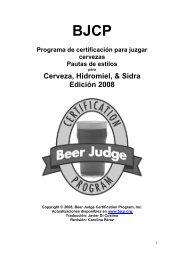Create successful ePaper yourself
Turn your PDF publications into a flip-book with our unique Google optimized e-Paper software.
III. <strong>BJCP</strong> STYLE GUIDELINESA. Introductionby David HousemanThe <strong>BJCP</strong> Style <strong>Guide</strong>lines use some specific terms with specialized meaning: “Category”,“Subcategory” and “Style.” When thinking of beer, mead and cider styles, the subcategory is the mostimportant label—”subcategory” means essentially the same thing as “style” and identifies the majorcharacteristic of one type of beer, mead or cider. The larger “categories” (or “style families” arearbitrary groupings of beers, meads or ciders, usually with similar character but some subcategories arenot necessarily related to others within the same category. The purpose of the structure within the <strong>BJCP</strong>Style <strong>Guide</strong>lines is to group styles of beer, mead and cider for competition purposes; do not attempt toderive additional meaning from these groupings.Historically, types of beers were a consequence of the local water, ingredients and technology availableat the time. In most cases, brewers did not set out to develop a specific “style,” or type of beer. Forexample, the high sulfates in the hard water around Burton-on-Trent resulted in a drier flavor thataccentuated the bitterness of well-hopped ales, while the soft water in Plzen enabled the brewers toproduce a pale lager with a high hop bitterness and soft palate that would not be possible with hardwater. Thus these classic styles were determined by the water of the region. Style guidelines also makedistinctions between similar styles. There are a number of Pilsners brewed in Germany, and althoughthere are variations, they can all be broadly classified in the German Pilsner style, but are sufficientlydifferent from the Bohemian Pilsners to deserve a separate sub-classification in the beer taxonomy.Beer styles are not static but change over time in history as ingredients, brewing technology andconsumer demand change. For example, the IPA described in the style guidelines originated in the UK,but is now rarely brewed due to the high taxes imposed on beers of this strength. History and geographyhighly impact the development of brewing; it is important that <strong>BJCP</strong> judges have an understanding ofthese factors. The examinee should be able to discuss these factors on the exam and use this depth ofknowledge when providing feedback to brewers.The beers documented in the <strong>BJCP</strong> Style <strong>Guide</strong>lines are those that are most commonly brewed byhomebrewers in the US. It is not a complete list of all known beers, even those available throughout theworld today. This style guide is continually kept up to date as newer information is made available. Itspurpose is to provide a definition of the commonly brewed beers which should be used by both thebrewer and the judge as criteria against which each style is evaluated. The <strong>BJCP</strong> Style <strong>Guide</strong>lines arenot intended to be the complete source of information for the prospective <strong>BJCP</strong> judge, although thelatest edition is quite complete and thorough. It’s recommended that the potential judge read and studyMichael Jackson’s New World <strong>Guide</strong> to Beer and Beer Companion, the Classic Beer Style Series andother sources of information to obtain a complete understanding of the history, geography, andcharacteristics of the beers described in the <strong>BJCP</strong> Style <strong>Guide</strong>lines. The <strong>BJCP</strong> Style <strong>Guide</strong>lines,however, should serve as an accurate, quick reference to the different types of beers.Most of the figures for starting gravity (SG), percent alcohol by volume (v/v), International BitteringUnits (IBU) and color (degrees Lovibond or SRM) are taken from one of several sources assimilated bythe <strong>BJCP</strong> Style Committee, including brewers of well-regarded commercial examples.39
















